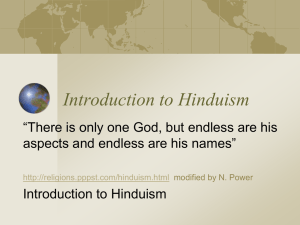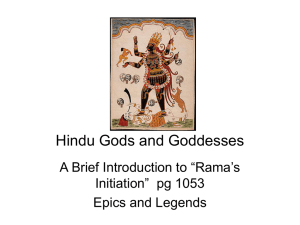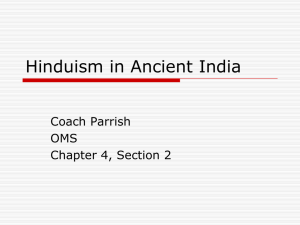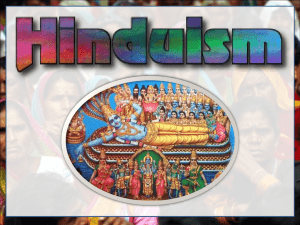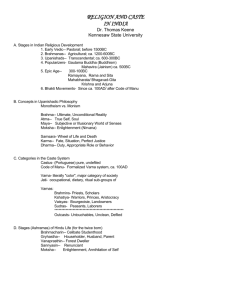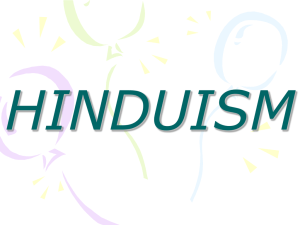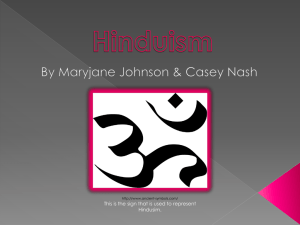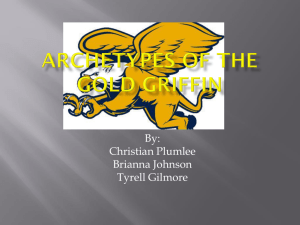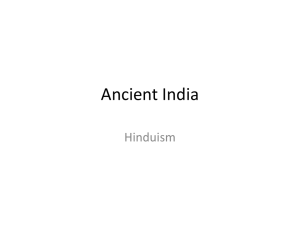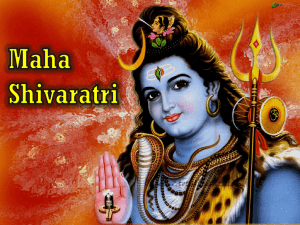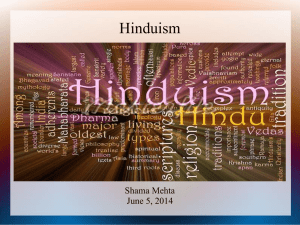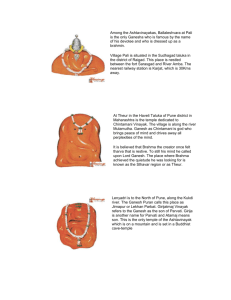Beliefs of Hinduism
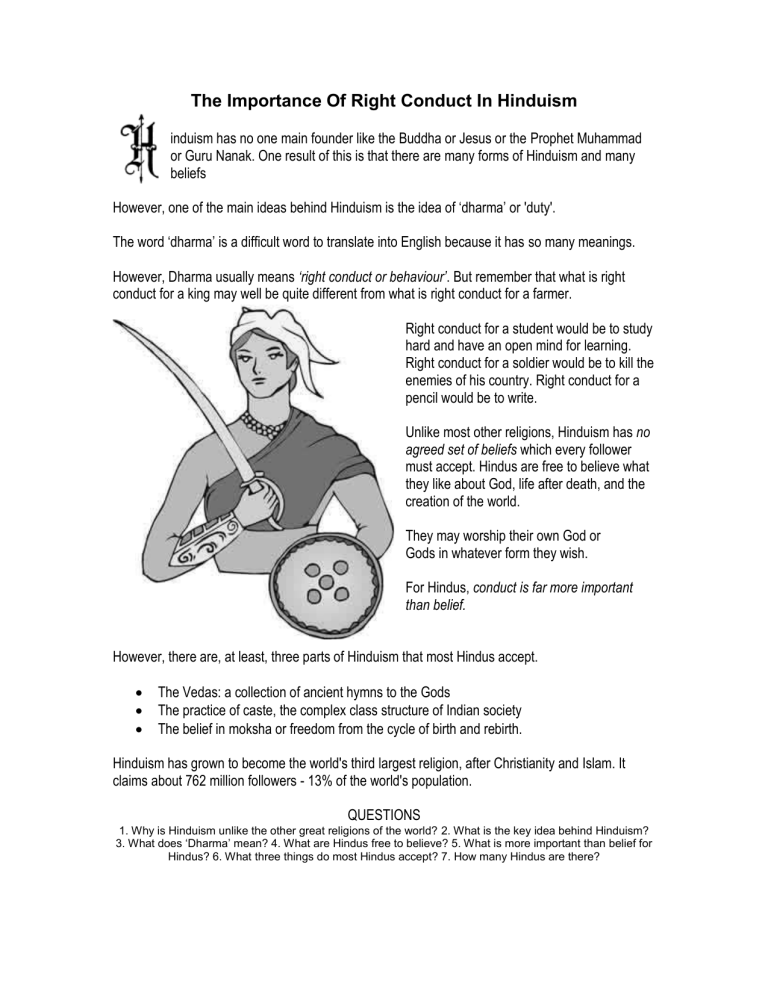
The Importance Of Right Conduct In Hinduism
induism has no one main founder like the Buddha or Jesus or the Prophet Muhammad or Guru Nanak. One result of this is that there are many forms of Hinduism and many beliefs
However, one of the main ideas behind Hinduism is the idea of ‘dharma’ or 'duty'.
The word ‘dharma’ is a difficult word to translate into English because it has so many meanings.
However, Dharma usually means ‘right conduct or behaviour’. But remember that what is right conduct for a king may well be quite different from what is right conduct for a farmer.
Right conduct for a student would be to study hard and have an open mind for learning.
Right conduct for a soldier would be to kill the enemies of his country. Right conduct for a pencil would be to write.
Unlike most other religions, Hinduism has no
agreed set of beliefs which every follower must accept. Hindus are free to believe what they like about God, life after death, and the creation of the world.
They may worship their own God or
Gods in whatever form they wish.
For Hindus, conduct is far more important than belief.
However, there are, at least, three parts of Hinduism that most Hindus accept.
The Vedas: a collection of ancient hymns to the Gods
The practice of caste, the complex class structure of Indian society
The belief in moksha or freedom from the cycle of birth and rebirth.
Hinduism has grown to become the world's third largest religion, after Christianity and Islam. It claims about 762 million followers - 13% of the world's population.
QUESTIONS
1. Why is Hinduism unlike the other great religions of the world? 2. What is the key idea behind Hinduism?
3. What does ‘Dharma’ mean? 4. What are Hindus free to believe? 5. What is more important than belief for
Hindus? 6. What three things do most Hindus accept? 7. How many Hindus are there?
The Main Gods And Goddesses In Hinduism
arly Hinduism was a form of nature worship. The forces of nature – the sun, the moon, rain, wind, lightning - were worshipped as gods. The earliest Hindu scriptures, the Vedas, (veda = knowledge) are a collection of hymns of praise to the gods of nature. They date from the period 1500 – 1000 BCE.
In Hinduism today, there are three main ways in which God may be understood:
As Brahman, the Ultimate Reality
As Brahma (the Creator), Vishnu (the Preserver), and Siva (the Destroyer) together known as the Trimurti (3 forms)
As an individual god or goddess such as Rama, Krishna, Ganesha or Durga.
Rama. The seventh incarnation of Vishnu is in the picture on the left with his wife Sita. Rama is the embodiment of right conduct or duty.
It is said that there are 330 million such gods and goddesses.
Knowledge of Brahman is one key idea in the
Upanishads. These are Hindu scriptures written in between the seventh and second centuries
BCE.
These are in the form of conversations between a teacher and his students. (Upanishad means
‘sit down near’ and describes the students sitting down near the teacher)
The idea of God taking three forms – Brahma,
Vishnu and Siva – appears in the Puranas
(purana = ancient), a collection of stories written about 900 CE.
Brahma, the Creator is not much worshipped in Hinduism today. By contrast Vishnu, the Preserver, is a favourite deity especially in two of the forms in which he is said to have appeared: Rama and
Krishna. Siva, the Destroyer, is another of the great gods of India. The figure of Siva Nataraja (Lord of the Dance), surrounded by fire (representing the Universe), stamping on a dwarf (which represents ignorance and unreality) appears frequently in Hindu art.
QUESTIONS
1. What did the early Hindus worship as gods? 2. What are the Vedas? 3. What are the three main ways in which God may be understood in Hinduism today? 4. What is the main idea or theme in the Upanishads?
5. What appears in the Puranas? 6. In what forms is Vishnu important today?
The Main Life Goals of Hindus
he main aim in life for a Hindu is to obtain moksha (freedom). This freedom allows a person to become one with Brahman, the Ultimate Reality. In order to achieve moksha, one has to free oneself from samsara.
Samsara is the cycle of births, deaths and rebirths which Hindus believe all humans are bound to follow.
The number of births any individual must have is determined by their actions. This includes both ritual actions, such as worship and social actions, like looking after your family. In order to control one’s actions and their results one has to discipline the mind and body.
There are three goals in life which must be kept in balance if moksha is to be achieved. These are:
dharma, right conduct or doing one's duty
artha, material prosperity
kama, the enjoyment of the good things of life
The right balance of these is essential. If some one pursues material wealth or worldly pleasure without consideration of their duties to others, they would not be living a good life.
Equally a person who ignores material things altogether would not be able to provide for his or her family.
Hindus believe that every human being has within himself or herself something of God. Those who possess a very large measure of the divine are known as avatars.
The word ‘avatar’ is used to describe:
Incarnations (embodiments) of the gods such as Rama and Krishna who are believed to be incarnations of the God, Vishnu.
Holy people and teachers of any religion. A Hindu may regard Jesus or Muhammad as avatars, for example.
QUESTIONS
1. What is the main aim in life for a Hindu? 2. What must one do to achieve moksha? 3. What is
Samsara? 4. What decides the number of births any individual must have. 5. What 3 goals in life must be kept in balance? 6. Why would it be wrong to ignore material things altogether? 7. What is an avatar?
Ganesha
any Hindus worship Ganesha, the elephant-headed God, first son of Shiva. Parvati, the wife of Shiva, longed for a child, but Shiva was usually away from home.
She made Ganesha from flakes of her own skin and breathed life into him. She asked Ganesha to guard the home while she took a bath.
Shiva returned home and tried to enter the house. “Keep out”, said Ganesha, to Shiva’s astonishment. Shiva had no idea who this cheeky fat boy could be.
“Get out of my way,” said Shiva, drawing his sword, but Ganesha bravely fought him. Shiva struck off Ganesha’s head. As it lay on the ground, Parvati came out. “You have killed our son,“ she screamed.
Shiva, full of regret, said that he would find a new head for Ganesha, the head of the next animal that he saw.
When he looked around he first saw an elephant.
Ganesha is seen as the giver of fortune, and is usually the first god to be worshipped on formal occasions. He is often shown as having four hands. In his hands he holds a rosary, a whip, a hatchet and some sweets.
The rosary represents time, and indicates that Ganesha is the god who controls death. The whip shows that
Ganesha controls all human activity, and the fate of all mankind is within his power. The hatchet is to destroy ignorance and the sweets are to reward those who overcome ignorance.
Ganesha has a big belly to show that believers should be solid or firm in their beliefs. His elephant head and the mouse at his feet show that he is the Lord of all creatures, large and small. His noble face represents the sacred syllable Aum, the word spoken by Brahma at the creation.
His big ears are supposed to show that there are many stories about him in the Hindu scriptures and his small eyes remind the believer of the importance of meditation. Hindus usually meditate with their eyes half closed. His hand position means ‘Do not fear’. The cobra around his waist is a reminder of his father, Shiva, who is always seen with a snake.
QUESTIONS
1. Who was Ganesha the son of? 2. How was Ganesha created? 3. Why did Shiva cut his head off? 4. Why did Shiva choose the head of an elephant? 5. Explain the meaning of the mala, the whip, the hatchet and the sweets. 6.
What do Ganesha’s big ears, small eyes and big belly represent? 7. What does the cobra around his waist remind us off?
The Goddess Durga or Kali
he Goddess Durga (or Kali), the wife of Shiva, is a fierce form or way in which the Mother
Goddess shows herself. The Mother Goddess is a symbol of all divine forces. Durga is also known to some Hindus as Parvati.
According to Hinduism, God creates, maintains and destroys the universe but the power with which he performs these tasks is called Shakti (universal energy).
This Shakti or power is worshipped alongside God as the Divine Mother. This is one reason that Hindus pay great respect to their human mothers. The mother’s blessings are seen as a necessity for a happy life by her children in all walks of life.
For example, when a child leaves the house he or she touches their mother’s feet and on return does the same. In her old age she is protected and cared for by her own children. The idea of placing her in a home to be cared for by others is abhorrent to Hindus.
Durga is usually shown seated on a tiger or lion, and has ten or more hands holding weapons or gifts. The story of Durga is told in the Puranas. It tells of a buffalo-demon, Mahshasura, who gained
Brahma’s favour. Brahma proclaimed that no male warrior could destroy Mahshasura.
The demon assumed that no woman could defeat him and even began to attack Brahma. The gods asked Shiva for help. In his anger a beam of light shone from Shiva’s eyes, then from the eyes of the other gods. The beams fused together and there in the middle was the ten-armed goddess, Durga.
The gods gave her weapons and a tiger arrived for her to ride on into battle with the demon. Mahshasura mocked Durga, but she opened her mouth and out marched an enormous army. The demon and his army was defeated. Durga holds the following weapons and other objects in her hands.
A trident (a traditional weapon of Rudra the Storm God, who became Shiva)
A goad or dagger
A mace to show that those who surrender need not fear death
A bell, A flail, An arrow
A lotus flower, a symbol of the universe and of mankind
A sword to destroy ignorance
A disk, the wheel of time
A bow to protect her followers against demons, A shield,
A conch shell, representing the four kinds of sound mentioned in the Vedas
A rosary, to remind believers of the importance of chanting mantras.
QUESTIONS
1. Who is the Goddess Durga? 2. Who is the Mother Goddess? 3. How do Hindus treat their mothers and why? 4. What did Brahma promise the demon Mahshashura? 5. How and why was Durga created by Shiva and the other Gods? 6. What happened to the demon? 7. What is the meaning of the following symbols held by Durga: a lotus flower; a sword; a rosary?
The Avatars of Hindu
ishnu, the Preserver, is worshipped in many forms. He is said to have appeared in nine different avatars or embodiments of God to save people. These stories are often fascinating and thrilling and command attention.
Matsya, the fish. When the world was threatened by a great flood. Vishnu became a fish and told a holy man, Manu, to build a boat. When the flood came, the fish pulled the boat to safety.
Kurma, the tortoise. After the flood, the divine food amrit (nectar) was lost, and Vishnu became a tortoise to help look for it.
Varaha, the boar. The world was thrown back into the cosmic ocean by the demon
Hiranyaksha, who could not be killed by any god or animal except a boar. Vishnu became a boar and saved the world.
Nara-simha, the man-lion. The world was threatened by the demon Hiranyakasipu who could not be killed by god, man or beast, by day or night, inside or outside his house.
Vishnu became a man-lion and killed him at twilight on the threshold of his house.
Vamana, the dwarf. The demon Bali had conquered the world of the gods. Vishnu became
Vamana, and asked Bali to give him as much land as he could cover in three strides.
When Bali agreed Vamana suddenly became so tall that he covered the kingdom in two strides and crushed Bali with the third stride.
Parasurama, Rama-with-an-axe. When the warrior race were persecuting the rest of the world, including the brahmins (priests), Vishnu appeared as Rama-with-an-axe and defeated the warriors.
Rama. Rama is one of the two most popular avatars. His story is told in the Ramayana
Krishna (pictured left) is the other most popular Hindu God. He appears in the
Mahabharata.
The Buddha, Gautama, who lived in the sixth and fifth centuries BCE and was the founder of Buddhism
Kalki – the tenth avatar is still to come. He will appear riding on a white charger, waving the sword of destruction, to end this world and build a new one.
QUESTIONS
1. How many times has Vishnu already appeared as an avatar (god in bodily form)? 2. Why did Vishnu come to earth as a boar? 3. Why did Vishnu come to earth as a man-lion and why did he kill the demon at twilight?
4. How did Vamana defeat Bali? 5. Why did Vishnu appear as Rama-with-an-axe? 6. Where is the story of
Rama told? 7. Where is the story of Krishna told? 8. Who was the 9th avatar? 9. Who is Kalki? 10 Who is playing the flute?
